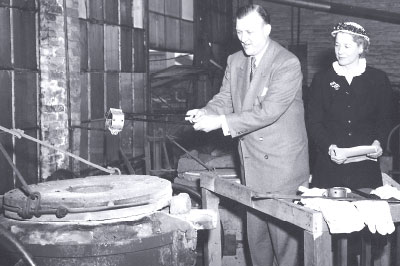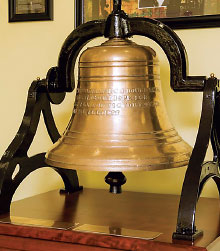History of Patient Advocacy in Psychiatry: from Passive Patient to Active Participant
Abstract
Over the course of a century, the voices of patients and their families have become more prominent in treatment decisions and the quest to improve access to care.

For years, people with mental illness played little to no part in determining the course of their treatment or their lives. However, one man’s experience over a century ago began to challenge that situation. Clifford Beers, diagnosed with what today is called bipolar disorder, regularly—sometimes obsessively—wrote about living with a mental illness. He spent almost three years in psychiatric hospitals and later chronicled his experiences in A Mind That Found Itself.

Maryland Gov. Theodore McKeldin in 1953 drop a shackle used to restrain people with mental illnesses into a metal mold to create the Mental Health Bell (photo below). With him is Mrs. A. Felix DuPont.
“A pen rather than a lance has been my weapon of offense and defense,” he wrote. “I have felt sure that I should one day prick the civic conscience into a compassionate activity, and thus bring into a neglected field earnest men and women who should act as champions for those afflicted thousands least able to fight for themselves.”
In 1909 Beers helped create the National Committee for Mental Hygiene, the predecessor of today’s Mental Health America (MHA). The organization focuses on national policy, legislation, and regulation, advocating with federal agencies whose actions affect the lives of people with mental illness.
“Over the century since [Beers], the place of the people most closely involved with mental illness has moved from the inner fastness of the asylum to the wider world,” said Theresa Nguyen, L.C.S.W., the vice president for Policy and Programs at MHA. “Consumers, their families, and those who most closely help them are more directly involved in advocacy.”
Patient Advocacy Movement Grows
There were other roots to the patient advocacy movement besides Beers’ activities, many arising in the 1930s, said Kenneth Thompson, M.D., a clinical assistant professor of psychiatry at the University of Pittsburgh and past president of the American Association for Social Psychiatry.
One was the development of organizations like Alcoholics Anonymous, which were based on group support by and for people with a specific disorder. Recovery Inc. (now Recovery International) was started in 1937 by psychiatrist Abraham Low, M.D., to help “patients who sought to re-enter society after hospitalization, to talk about their conditions, and to eliminate the stigma of mental illness … [using a] cognitive-behavioral, peer-to-peer, self-help training system,” according to Recovery International’s website.
A third was the development of group therapy, a treatment approach that values the thoughts and opinions of people with mental illness as part of their own treatment and others’. “It’s like people as therapy for each other,” said Thompson. “And in asylums, there very likely developed informal support networks of patients for patients that may have carried over into the outside world.”

In fact, in the mid-1940s, a group of former patients from the New York state hospital system banded together to create Fountain House in New York City, the first clubhouse model. The clubhouse was not designed as a place for clinical treatment but as a place to help members prepare for employment and find housing, organizing their time around “the work-ordered day.” Fountain House, which is still thriving today, was a successful move by people living with mental illness or its aftermath to run their own lives and function in the wider world.
In the 1950s and 1960s, families of people with mental illness began organizing on behalf of their loved ones as they were released from state asylums following the introduction of new psychiatric medications and the move toward deinstitutionalization. Many former patients ended up in the care of their aging parents—parents who had been blamed by psychoanalysts for causing their children’s mental illness in the first place.
“They were put off by the notion of ‘schizophrenogenic’ parents,” said Herbert Pardes, M.D., a professor of psychiatry at Columbia University, former director of the National Institute of Mental Health, and former APA president. Pardes helped encourage the creation of family-led organizations like the National Alliance for the Mentally Ill (now named the National Alliance on Mental Illness [NAMI]) and the National Alliance for Research on Schizophrenia and Depression (now named the Brain & Behavior Research Foundation [BBRF]), for which he serves as president of its Scientific Council. Pardes has been widely honored for his strong advocacy on behalf of patients and their families.
NAMI was founded in 1979 by parents who sought to advocate for their children with mental illness and to help families cope better with their children’s illness. Today, the NAMI board also includes people with mental illness. BBRF has raised and distributed $400 million in more than 5,700 grants to more than 4,700 scientists around the world for psychiatric and neuroscience research. (Psychiatric News Editor-in-Chief Jeffrey Borenstein, M.D., is president and CEO of BBRF.)
In time, other groups dedicated to specific diagnoses sprang up to support and advocate for patients with those illnesses: Autism Speaks, the Alzheimer’s Association, the Anxiety and Depression Association of America, the Schizophrenia and Related Disorders Alliance of America, and numerous others.
APA has a long and close relationship with patient advocacy groups, especially on federal and state issues. “APA’s mission is to improve access to psychiatric care,” said APA CEO and Medical Director Saul Levin, M.D., M.P.A. “We very much value our partnerships with patient advocacy groups. While APA is constantly working with legislators and policymakers on that goal, it is the patients and their families who can share their personal stories about the tragedies they have endured and the many obstacles they have encountered in obtaining care. Together, our voices are much stronger and can make a greater impact for creating a mentally healthy nation.”
Harnessing the Power of Peer Support
In many ways, the rise of the patient advocacy movement also paralleled the civil rights movement by resisting dehumanizing stereotypes of people with mental illness, said MHA’s Nguyen.
Much of the change today is led by young people, she added. “They are not afraid to talk about mental health and to publicly challenge stereotypes. This allows for more conversation about mental health without fear of discrimination.” Perhaps the most significant advance for people with mental illness is the rise in recent decades of the role of people who have lived with mental illness, whether they are in treatment or recovery, and who work with psychiatrists and mental health professionals to help other patients through the treatment process.
Individuals working in peer support have some training and serve as a bridge between patients and clinicians. Patrick Bailey, a peer specialist for four years with the New York State Department of Mental Health’s Rochester Psychiatric Center, talks with patients about his life as a person recovering from anxiety, obsessive-compulsive disorder, and addiction.
“I hope patients listen to us because we’re sharing our own lived experiences,” Bailey told Psychiatric News. “I want them to see that recovery is possible and that they can live a life free of symptoms.”
As a peer specialist, Bailey runs group sessions, talks to patients, helps them navigate the complexities of the mental health system, and serves as a liaison between patients and the hospital staff. Maintaining good working relationships with the clinical staff is an important part of supporting the patient, he added. “I have to be more relatable to the patients than other staff members while being professional enough to be accepted by the staff.”
Initially, some mental health professionals considered peer support a replacement for their own work. More recently, however, psychiatrists see peers as adjuncts who can help keep patients in treatment. “Peers represent a great recommendation for our work in helping people,” said Thompson. “They bring the credibility of real experience as they reinforce what we do.”
APA agreed in its 2018 Position Statement on Peer Support Services: “Psychiatrists should be knowledgeable of the value and efficacy of the wide array of peer support services in recovery and support the integration of these services into the comprehensive continuum of care.” The statement also calls for appropriate training and compensation for peers.
“Most states now have some sort of peer-support certification, but we [at MHA] are looking to create a national certification program and standards to permit mobility and to obtain insurance coverage for their work,” said MHA’s Nguyen.
Advocacy by people with mental illness and their families for parity, improved treatments, more research, and less stigma toward people with mental illness has made progress—although much remains to be done. Clifford Beers would no doubt be pleased with the efforts of families and patients alike.
“More fundamental, however, than any technical reform, cure, or prevention—indeed, a condition precedent to all these—is a changed spiritual attitude toward the insane,” wrote Beers a century ago. “They are still human: they love and hate and have a sense of humor. The worst are usually responsive to kindness.” ■
APA’s Position Statement on Peer Support Services is posted here.



